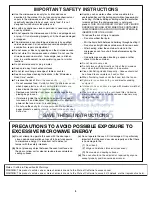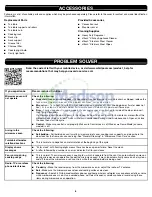
4
Energy Save
To conserve energy, the Clock will automatically turn off when the
microwave oven goes into standby mode. Touch OPTIONS/CLOCK to
reach the Clock and Energy Save submenu, and follow the prompts to
turn on Clock.
Language (on some models)
Language of the display text may be changed. Touch the OPTIONS/
CLOCK to reach the Language submenu, and follow the prompts to set
language to English or French.
Calibrate Temp
The actual convection cooking temperature may be calibrated higher or
lower than the displayed temperature. For example, if you want the
microwave oven to be a bit hotter, you may try setting the calibration
to +10°. Touch OPTIONS/CLOCK to reach the Calibration submenu.
The current setting will appear in the display with a checkmark next
to it. Use number pads to select temperature variations in degrees
Fahrenheit: 1= ±0° (reset to default), 2= +5°, 3= +10°, 4= +15°,
5= +20°, 6= -5°, 7= -10°, -8= -15° and 9= -20°.
NOTE: The microwave oven will remember the setting after a power
failure.
Features
CLEANRELEASE
®
Cavity Coating (on some models)
The durable, nonstick coating resists soil buildup by making cleaning
easier. See “Microwave Oven Care” section.
6th SENSE
®
System
A sensor in the microwave oven detects moisture released from food as
it heats, and adjusts the cooking time accordingly.
Convection Element and Fan
The convection element and fan are embedded in the wall of the
microwave oven cavity, behind the metal screen.
Cooking Rack
Use the rectangular cooking rack only for 2-level cooking. To avoid
damage to the microwave oven, always remove rack after 2-level
cooking. To avoid damage to the microwave oven due to soil buildup,
clean rack supports often.
Turntable
Turntable may be turned off for manual cooking only. This is helpful
when cooking with plates that are bigger than the turntable, or when
cooking with plates that are side by side. Turntable cannot be turned off
during preset or sensor (on some models) functions.
Accessories
Convection Rack
Use the short convection rack for convection cycles (baking or
roasting). Place cookware directly on rack for bake and for some roast
functions. Some roast functions require that the food be placed directly
on the rack. Use a microwave-safe, ovenproof dish or pan under the
rack to catch the drippings.
Steamer Vessel
Use the steamer vessel base, insert and lid for steaming, or use just the
base and lid for simmering.
Cookware and Dinnerware
Microwave-Safe
■
Browning dish (Follow manufacturer recommendations.)
■
Ceramic glass, glass
■
China, earthenware (Follow manufacturer recommendations.)
■
Melamine (Follow manufacturer recommendations.)
■
Paper towels, paper plates, napkins (Use non-recycled paper.)
■
Plastic wraps, bags, covers, dinnerware, containers (Follow
manufacturer recommendations.)
■
Pottery and clay (Follow manufacturer recommendations.)
■
Silicone bakeware (Follow manufacturer recommendations.)
■
Wax paper
Do Not Use
■
Metal cookware and bakeware
■
Straw or wicker
■
Gold, silver or pewter
■
Non-approved meat thermometers, skewers
■
Twist ties
■
Foil liners, such as sandwich wrappers
■
Staples
■
Objects with gold or silver trim or with metallic glaze
To Test Cookware/Dinnerware: Place dish in microwave oven with 1 cup (250 mL) of water beside it. Program 1 minute of cook time at 100%. If
dish becomes hot and the water stays cool, do not use the dish in the microwave oven.
Accessory Configurations
Roasting
Baking
Steaming
Simmering
A. Turntable
B. Pan (not provided)
C. Convection rack
D. Cookie sheet (not provided)
E. Steamer base
F. Steamer insert
G. Steamer lid
A B C
A C D
E F G
E G


























